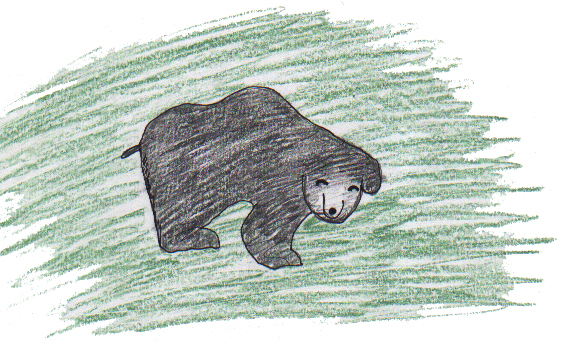 This collection of student work is from Frank Keim's classes. He wants to share these works for others to use as an example of culturally-based curriculum and documentation. These documents have been OCR-scanned and are available for educational use only.
This collection of student work is from Frank Keim's classes. He wants to share these works for others to use as an example of culturally-based curriculum and documentation. These documents have been OCR-scanned and are available for educational use only.Special | A | B | C | D | E | F | G | H | I | J | K | L | M | N | O
P | Q | R | S | T | U | V | W | X | Y | Z | ALL
Sloth Bears by Tanya Peter:Toward the end of the eighteenth century the first pelts of the Sloth bear arrived in Europe. The name "bear Sloth" was quickly reversed to "Sloth bear " The typical Sloth bear has a long, shaggy, unkempt, blackcoat, and a prominent white or yellow chevron or y marking on its chest. The hair is longer and shaggier than other bears, particularly on the back of the neck and between the shoulders. The belly and underleg hair is sparse, possibly to help keep the animal cool on hot days. The bear has no front teeth, and the bony palate is hollowed out.The feet have white, blunt, curved claws up to three inches (7.6 cm)long. Sloth bears grow about six feet (1.8m) long, and stand three feet (91 cm) high at the shoulder. They have a 6-7 inch long tail Big males can weigh up to 300 pounds. Females are generally smaller. Somewhere between 7,000 and 10,000 Sloth bears are estimated to still exist in the world. They are found in the forested areas on the island of Sri Lanka and the Indian subcontinent, northward to the base of the Himalayas, and eastward to Assan. They are also known to occur in Nepal's Chitwan National Park. They were also common in India two decades ago, but today Sloth bears appear to be rapidly disappearing over most of their range. Sloth bears are mainly nocturnal, but can be active at any hour during the day. Their usual gait is a slow, shambling walk, but when frightened, they can break into a gallop, moving faster than a running person. They do not climb trees to escape danger, they simply play dead. The male bears mark trees by scaping the trunks with their forepaws and then rubbing the trunk with their flanks. In the wild, Sloth bears retreat to caves during the long rainy periods. Sloth bears are good climbers and scale trees to shake down fruit or to raid a bee's nest. Honey is an especially favored food. Although the bears may cry in pain when stung by angry bees, they will persist until all the honeycomb has been eaten. Their other foods include ants, berries, and the occasional scavenged tiger kill. In India, the mating season runs from April through June. Sloth bear courtship is a very noisy affair and includes much hugging and mock fighting. Most births occur in December or early January. Usually two, sometimes three, small cubs are born in a cave or shelter dug under a boulder. They are born blind and remain so for about three weeks. When the cubs are about four or five weeks old the den is abandoned. Sloth bear mothers regularly carry their young to and from the feeding grounds on their backs. One cub might always ride on the mother's shoulders, the other clinging to her rump. The mother Sloth bear may carry her young until they are nearly a third her size. Adult male bears are very gentle toward cubs and have even been seen traveling in family groups. Villagers in India believe the father helps to raise his offspring. Sloth bears are a unique bear and attempts are being made to save them from extinction. By: Tanya Peter | |
|



